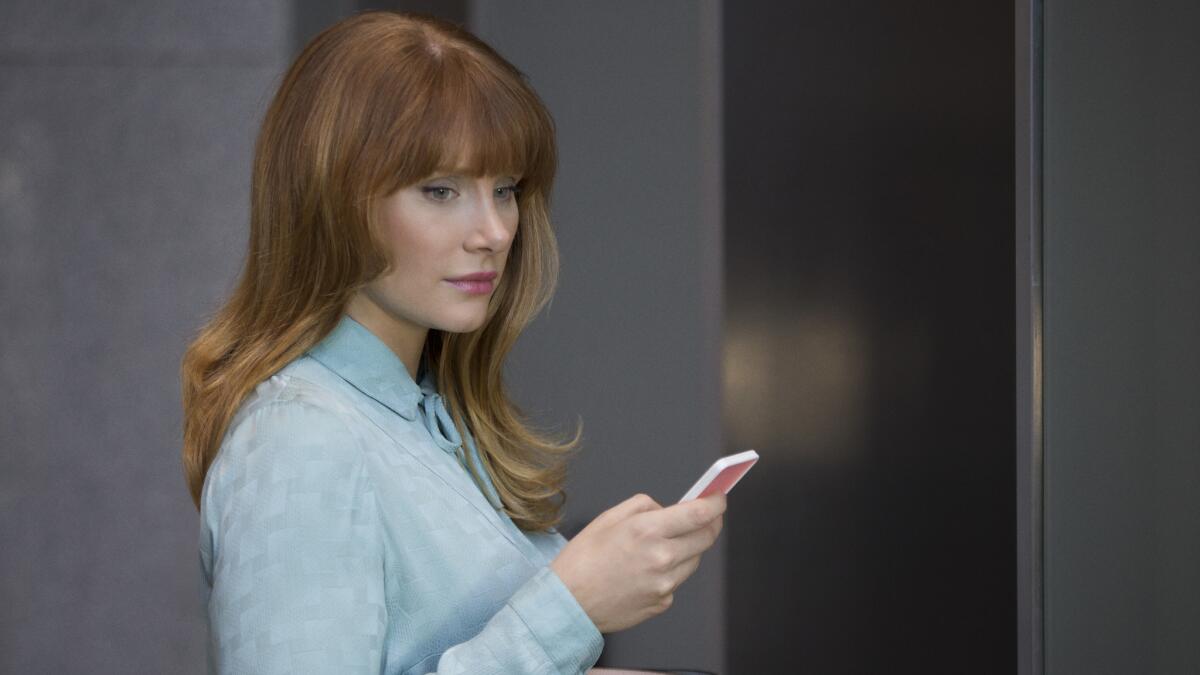‘Black Mirror’s’ rare glimpse of technology as a means to joy earns an Emmy nod
What do you do when the television series you’ve created becomes synonymous with the bleak, dystopian elements of technology? If you’re “Black Mirror” mastermind Charlie Brooker, you startle your audience with “San Junipero,” the first episode of the Netflix anthology series in which technology is put to purely joyful use.
Set in a kind of ’80s retro paradise, “San Junipero” follows the romance between Kelly (Gugu Mbatha-Raw) and Yorkie (Mackenzie Davis), two young women who, we eventually understand, are not exactly who they seem to be. (Spoilers ahead; stop here if you don’t want details.) It’s become “Black Mirror’s” most celebrated episode, garnering an award from the LGBTQ organization GLAAD and two Emmy nominations (for TV movie and writing).
“ ‘San Junipero’ was a conscious attempt by me to blow up what the show was,” Brooker says by phone from the U.K., where he is currently editing the show’s fourth season. “We don’t want to be predictable, and if every single episode we did had a harrowing ending …” He lets his words trail off, then explains that the inspiration grew out of a documentary he’d seen about nostalgia therapy, in which nursing homes surround elderly residents with the sounds and clothing of their youth to rejuvenate them. “I thought, ‘Hmm, let’s imagine this using VR technology.’ ”

Brooker initially envisaged heterosexual lovers at the story’s center but says he quickly realized that “there are extra layers of resonance with a same-sex couple.” In 1987, two women might not have been able to romance each other as publicly as the two women do in the episode; they certainly could not have gotten married. In fact, the story functions as a kind of coming-out tale.
“They are both people who have denied themselves, or have been denied, a whole aspect of their humanity in what you might call Life #1,” Brooker says. “And now they have a second shot at it.”
The Internet is teeming with dark conspiracy theories about the episode’s conclusion, which intercuts the women driving into the sunset with a computer-server room of blinking lights. But Brooker insists he intended it as a happy ending: “I didn’t want to see these characters getting punished by the universe in some way. It felt more unexpected and sweeter to let them literally drive off into the sunset. [The intercutting of the scenes] is simultaneously a beautiful image and a slightly unsettling one, but the reality they are experiencing is pretty joyful.”
Much of the fun of “San Junipero” comes from its retro soundtrack and pop cultural references. Brooker, a former video-game journalist who was a teenager in that era, took great pains to use arcade games from the ’80s and planted little jokes and Easter eggs to amuse fans on repeat viewings. (Song choices like “Living in a Box” and “Heaven Is a Place on Earth” take on a new resonance once you’ve grasped the scenario.)
It was the emotional narrative that riveted many viewers, though. For the LGBTQ community, “the representation really matters to them and really touches them,” Brooker suggests. “To everyone else it is just a very universal love story. They are the richest characters that I have come up with, really, in any of the stories I’ve done. Their sexuality is both totally irrelevant to who they are and terribly relevant to the story at the same time.”
“San Junipero” also stands as an antidote to the trend in which TV shows kill off lesbian or bisexual characters. “It’s a wonderful irony that we’ve managed to subvert that [Bury Your Gays trope] in a way, because we resurrect these women. I’ve heard people say that they like to think all of their favorite TV same-sex couples are now in San Junipero!” In fact, the “Orange Is the New Black” team shot a spoof called “Orange Is the New Black Mirror” earlier this year in which dead lesbian character Poussey is reunited with her best friend Taystee in San Junipero.
Brooker says he has no plans to write a sequel to the episode. “I have steered clear of revisiting the San Junipero world because we want to keep them happy there. You wouldn’t want anyone at that company opening the wrong email attachment and suddenly the whole place is held hostage by ransomware. That would be hellish.” He pauses ominously. “There’s an episode idea!”
Has obsessively probing the potential horrors of technology made Brooker feel better or worse about the future? “I am neurotic and I worry about things a lot, but I am basically pro-technology,” he says. “I don’t know if doing the show has changed my way of thinking, but exploring all my nightmares has probably been very therapeutic for me.”
See the most read stories this hour »
More to Read
From the Oscars to the Emmys.
Get the Envelope newsletter for exclusive awards season coverage, behind-the-scenes stories from the Envelope podcast and columnist Glenn Whipp’s must-read analysis.
You may occasionally receive promotional content from the Los Angeles Times.











